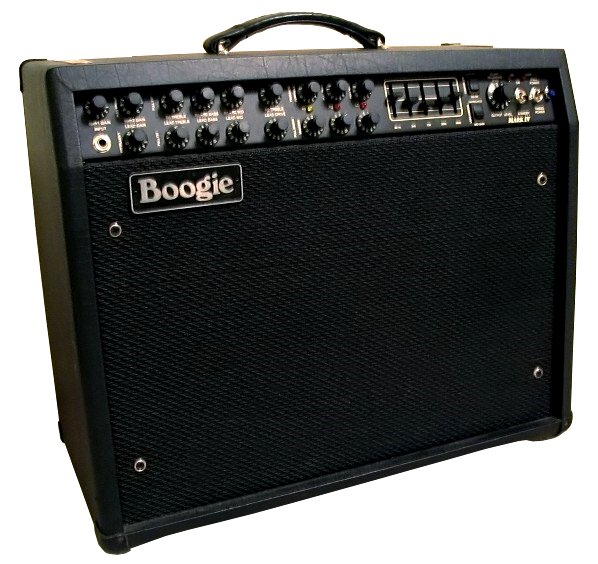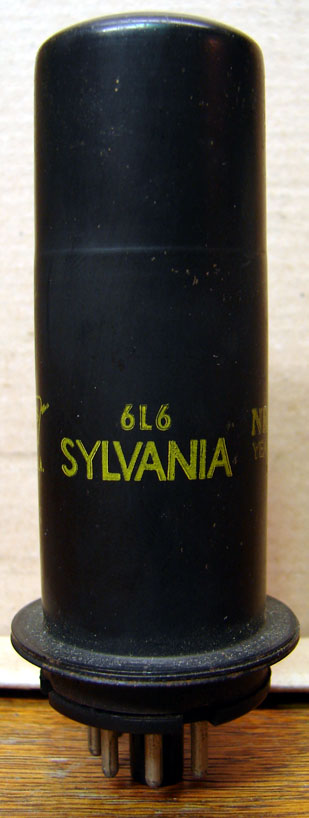|
Fender Tremolux
The Fender Tremolux was a guitar amplifier made by Fender. It was introduced in the summer of 1955 with a rated power output of 15 watts, cathode bias, two 6V6 output tubes, and a 5V4 tube rectifier. The Tremolux was the first Fender amp with a built in effect, tremolo."Watch Fender Tremolux Video" Retrieved May 20, 2014. In 1957, the rated power output of the Tremolux was increased to 18 watts when it changed to a fixed bias design and a 5U4 rectifier. In 1961, the Tremolux was changed from a 1×12 -fabric covered combo amp to a piggyback amp with oxblood grillcloth, covered with cream |
Guitar Amplifier
A guitar amplifier (or amp) is an electronic device or system that strengthens the electrical signal from a pickup on an electric guitar, bass guitar, or acoustic guitar so that it can produce sound through one or more loudspeakers, which are typically housed in a wooden cabinet. A guitar amplifier may be a standalone wood or metal cabinet that contains only the power amplifier (and preamplifier) circuits, requiring the use of a separate speaker cabinet–or it may be a "combo" amplifier, which contains both the amplifier and one or more speakers in a wooden cabinet. There is a wide range of sizes and power ratings for guitar amplifiers, from small, lightweight "practice amplifiers" with a single 6-inch speaker and a 10-watt amp to heavy combo amps with four 10-inch or four 12-inch speakers and a 100-watt amplifier, which are loud enough to use in a nightclub or bar performance. Guitar amplifiers can also modify an instrument's tone by emphasizing or de-emphasizing certain f ... [...More Info...] [...Related Items...] OR: [Wikipedia] [Google] [Baidu] |
Fender Musical Instruments Corporation
The Fender Musical Instruments Corporation (FMIC, or simply Fender) is an American manufacturer of instruments and amplifiers An amplifier, electronic amplifier or (informally) amp is an electronic device that can increase the magnitude of a signal (a time-varying voltage or current). It may increase the power significantly, or its main effect may be to boost th .... Fender produces acoustic guitars, bass amplifiers and public address equipment, however it is best known for its solid-body electric guitars and bass guitars, particularly the Fender Stratocaster, Stratocaster, Fender Telecaster, Telecaster, Fender Jaguar, Jaguar, Fender Jazzmaster, Jazzmaster, Fender Precision Bass, Precision Bass, and the Fender Jazz Bass, Jazz Bass. The company was founded in Fullerton, California, Fullerton, California by Leo Fender, Clarence Leonidas "Leo" Fender in 1946. Its headquarters are in Los Angeles, California. The FMIC is a privately held corporation, with Andy Mooney serv ... [...More Info...] [...Related Items...] OR: [Wikipedia] [Google] [Baidu] |
Cathode Bias
In electronics, cathode bias (also known as self-bias, or automatic bias) is a technique used with vacuum tubes to make the direct current (dc) cathode voltage positive in relation to the negative side of the plate voltage supply by an amount equal to the magnitude of the desired grid bias voltage. Operation The most common cathode bias implementation passes the cathode current through a resistor connected between the cathode and the negative side of the plate voltage supply. The cathode current through this resistor causes the desired voltage drop across the resistor and places the cathode at a positive dc voltage equal in magnitude to the negative grid bias voltage required. The grid circuit puts the grid at zero volts dc relative to negative side of the plate voltage supply, causing the grid voltage to be negative with respect to the cathode by the required amount. Directly heated cathode circuits connect the cathode bias resistor to the center tap of the filament transformer sec ... [...More Info...] [...Related Items...] OR: [Wikipedia] [Google] [Baidu] |
Tremolo
In music, ''tremolo'' (), or ''tremolando'' (), is a trembling effect. There are two types of tremolo. The first is a rapid reiteration: * Of a single note, particularly used on bowed string instruments, by rapidly moving the bow back and forth; plucked strings such as on a harp, where it is called '' bisbigliando'' () or "whispering". Tremolo picking, on traditionally plucked string instruments including guitar and mandolin, is the rapid articulation of single notes or a group of notes with a plectrum (pick) or with fingers. Tremolo playing sustains notes that would otherwise rapidly decay (fade to silence). * Between two notes or chords in alternation, an imitation (not to be confused with a trill) of the preceding that is more common on keyboard instruments. Mallet instruments such as the marimba are capable of either method. * A roll on any percussion instrument, whether tuned or untuned. A second type of tremolo is a variation in amplitude: * As produced on organs b ... [...More Info...] [...Related Items...] OR: [Wikipedia] [Google] [Baidu] |
Tweed (Fender)
Fender tweed is a generic name used for the guitar amplifiers made by the American company Fender between 1948 and 1960. The amplifiers are named for the cloth covering, which consists of varnished cotton twill, incorrectly called tweed because of its feel and appearance. They are praised for their sound, their circuitry considered "hallowed ground". Fender generally stopped using the twill covering in 1960, though the Harvard was still covered in twill until 1963, and the Champ until 1964. In 1953, Fender introduced the "wide panel" construction, where the top and bottom panels are wider than the side panels. In the later "narrow panels", introduced in 1955, all panels have approximately the same size. Later amplifiers used tolex for the covering. Beginning in 1990, Fender began to utilize the tweed covering once again, starting with the '59 Bassman Reissue. Some later amplifier models came in the split option of tweed or black tolex covering, including the Blues Junior and ... [...More Info...] [...Related Items...] OR: [Wikipedia] [Google] [Baidu] |
Tolex
Tolex is a trade name for a flexible, waterproof, vinyl material used as a cover material for books, upholstery, guitar amplifiers, cases, and other products. Tolex was filed as a trademark on August 30, 1945 by the General Tire, and was registered as "a plastic sheet and film material for book binding and case covering for speakers and amplifiers". General Tire was disconglomerated, and the trademark expired in 2005. TOLEX is a Canadian trademark and brand of OMNOVA Solutions, Fairlawn, Ohio, now part of Synthomer. Usage It has been used in Henney-Packard hearses and ambulances of the 1950s, Fender amplifiers, the Fender Rhodes electric piano, and guitar cases from various manufacturers. Tolex was also used in Packard automobiles, hearses, and ambulances, and in marine applications, such as Chris-Craft boats and other watercraft. Musicians sometimes use "Tolex" as a generic description for any vinyl type covering on an amplifier or guitar case, but most are not actuall ... [...More Info...] [...Related Items...] OR: [Wikipedia] [Google] [Baidu] |
EL84
The EL84 is a vacuum tube of the power pentode type. It is used in the power-output-stages of audio-amplifiers, most commonly now in guitar amplifiers, but originally in radios. The EL84 is smaller and more sensitive than the octal 6V6 that was widely used around the world until the 1960s. An interchangeable North American type is the ''6BQ5'' (the RETMA tube designation name for the EL84). The EL84 was developed to eliminate the need for a driver tube in radios, so it has rather more gain than is usual in a power pentode. Eliminating a preamplifier triode in radios made them cheaper. Manufacturers were quick to adopt it in general use, and they are found in many old European tube-radios and other audio equipment. A single EL84 was used in low-cost equipment, and a push–pull pair for lower distortion and higher power. In common with all 'E' prefix tubes, using the Mullard–Philips tube designation, it has a heater voltage of 6.3V. It can produce 17W output in Class AB1 in ... [...More Info...] [...Related Items...] OR: [Wikipedia] [Google] [Baidu] |
6L6GC
6L6 is the designator for a beam power tube introduced by Radio Corporation of America in April 1936 and marketed for application as a power amplifier for audio frequencies.J. F. Dreyer Jr."The Beam Power Output Tube" New York: McGraw-Hill, ''Electronics'', April 1936, pp. 18 - 21, 35 The 6L6 is a beam tetrode that utilizes formation of a low potential space charge region between the anode and screen grid to return anode secondary emission electrons to the anode and offers significant performance improvements over power pentodes. The 6L6 was the first successful beam power tube marketed. In the 21st century, variants of the 6L6 are manufactured and used in some high fidelity audio amplifiers and musical instrument amplifiers. History In the UK, three engineers at EMI (Isaac Shoenberg, Cabot Bull and Sidney Rodda) had developed and filed patents in 1933 and 1934 on an output tetrode that utilized novel electrode structures to form electron beams to create a dense space charge r ... [...More Info...] [...Related Items...] OR: [Wikipedia] [Google] [Baidu] |
Cream (Fender)
Cream is a dairy product composed of the higher-fat layer skimmed from the top of milk before homogenization. In un-homogenized milk, the fat, which is less dense, eventually rises to the top. In the industrial production of cream, this process is accelerated by using centrifuges called " separators". In many countries, it is sold in several grades depending on the total butterfat content. It can be dried to a powder for shipment to distant markets, and contains high levels of saturated fat. Cream skimmed from milk may be called "sweet cream" to distinguish it from cream skimmed from whey, a by-product of cheese-making. Whey cream has a lower fat content and tastes more salty, tangy and "cheesy". In many countries partially fermented cream is also sold: sour cream, crème fraîche, and so on. Both forms have many culinary uses in both sweet and savoury dishes. Cream produced by cattle (particularly Jersey cattle) grazing on natural pasture often contains some carotenoid p ... [...More Info...] [...Related Items...] OR: [Wikipedia] [Google] [Baidu] |
Blackface Amp Control Plate (Fender)
Blackface is a form of theatrical makeup used predominantly by non-Black people, Black people to portray a caricature of a Black person. In the United States, the practice became common during the 19th century and contributed to the spread of Ethnic stereotype, racial stereotypes such as the "happy-go-lucky List of ethnic slurs#D, darky on the plantation" or the "dandy, dandified List of ethnic slurs#Coon, coon". By the middle of the century, blackface minstrel shows had become a distinctive American artform, translating formal works such as opera into popular terms for a general audience. Early in the 20th century, blackface branched off from the minstrel show and became a form in its own right. In the United States, blackface declined in popularity beginning in the 1940s and into the civil rights movement of the 1950s and 1960s,Clark, Alexis.How the History of Blackface Is Rooted in Racism. ''History''. A&E Television Networks, LLC. 2019. and was generally considered highly of ... [...More Info...] [...Related Items...] OR: [Wikipedia] [Google] [Baidu] |
Optoisolator
An opto-isolator (also called an optocoupler, photocoupler, or optical isolator) is an electronic component that transfers electrical signals between two isolated circuits by using light. Opto-isolators prevent high voltages from affecting the system receiving the signal.Lee et al., p. 2. Commercially available opto-isolators withstand input-to-output voltages up to 10 kVHasse, p. 145. and voltage transients with speeds up to 25 kV/ μs.Joffe and Kai-Sang Lock, p. 279. A common type of opto-isolator consists of an LED and a phototransistor in the same opaque package. Other types of source-sensor combinations include LED- photodiode, LED- LASCR, and lamp-photoresistor pairs. Usually opto-isolators transfer digital (on-off) signals, but some techniques allow them to be used with analog signals. History The value of optically coupling a solid state light emitter to a semiconductor detector for the purpose of electrical isolation was recognized in 1963 by Akmenkalns, et ... [...More Info...] [...Related Items...] OR: [Wikipedia] [Google] [Baidu] |





